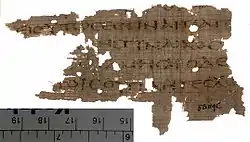Papyrus 71
Papyrus 71 (nach Gregory-Aland mit Sigel 71 bezeichnet) ist eine frühe griechische Abschrift des Neuen Testaments. Dieses Papyrusmanuskript des Matthäusevangeliums enthält nur die Verse 19,10–11.17–18. Mittels Paläographie wurde es auf das 4. Jahrhundert datiert.
| Papyrus 71 | |
|---|---|
 | |
| Name | P. Oxy. XXIV 2385 |
| Text | Matthäus 19 † |
| Sprache | griechisch |
| Datum | 4. Jahrhundert |
| Gefunden | Ägypten |
| Lagerort | Ashmolean Museum |
| Quelle | E. Lobel, C. H. Roberts, E. G. Turner, and J. W. B.Barns, OP XXIV (1957), S. 5–6. |
| Typ | Alexandrinischer Texttyp |
| Kategorie | II |
Text
Der griechische Text des Kodex repräsentiert den Alexandrinischen Texttyp. Kurt Aland ordnete ihn in Kategorie II ein.[1]
Aufbewahrungsort
Die Handschrift wird zurzeit im Ashmolean Museum (P. Oxy. 2385) in Oxford aufbewahrt.[1]
Einzelnachweise
- Kurt und Barbara Aland: Der Text des Neuen Testaments. Einführung in die wissenschaftlichen Ausgaben sowie in Theorie und Praxis der modernen Textkritik. Deutsche Bibelgesellschaft, Stuttgart 1989, S. 110. ISBN 3-438-06011-6
Bilder
- P. Oxy. XXIV Oxyrhynchus 2385 Oxyrhynchus Online
- 71 recto Matt. 19:10-11
- 71 verso Matt. 19:17-18
Literatur
- Edgar Lobel, Colin H. Roberts, E. G. Turner, and J. W. B. Barns, Oxyrhynchus Papyri, XXIV (London: 1957), S. 5–6.
This article is issued from Wikipedia. The text is licensed under Creative Commons - Attribution - Sharealike. The authors of the article are listed here. Additional terms may apply for the media files, click on images to show image meta data.